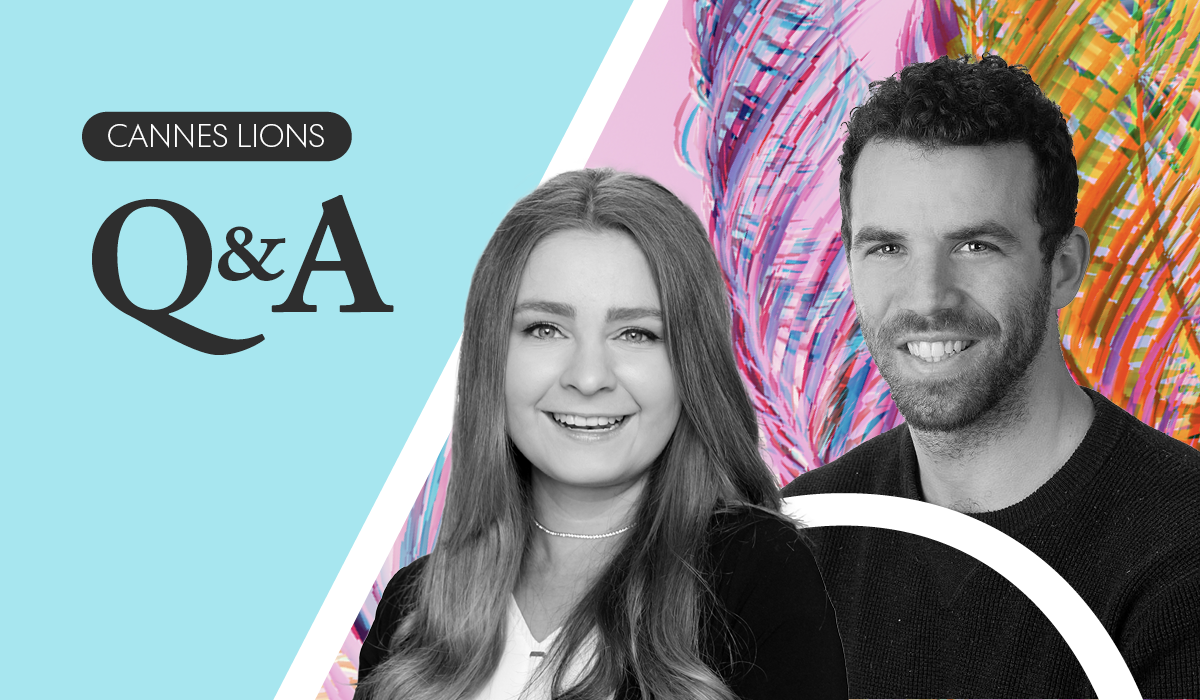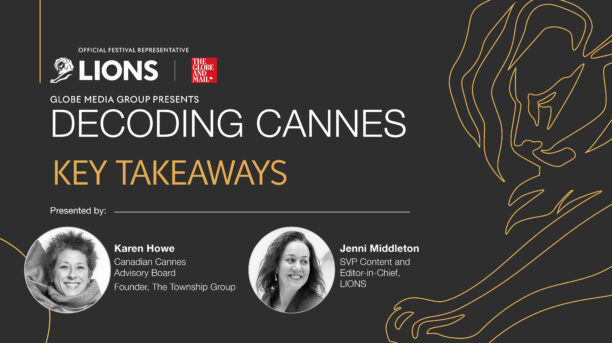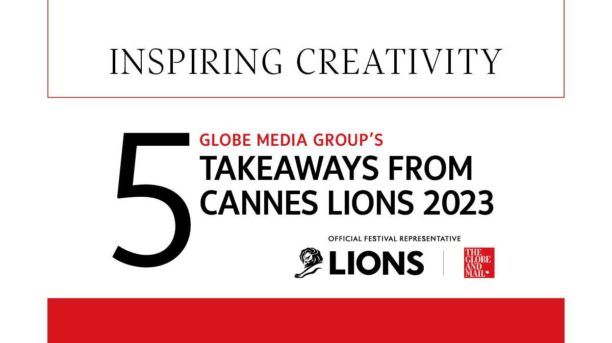Earlier this year, Shawn Weidman, Copywriter at Rethink, and Jaclyn McConnell, Art Director at Rethink, clinched the gold medal in the print category at the 2023 Canadian Young Lions Competitions. Last month they participated in the Global Young Lions Competitions at Cannes Lions. Here are their takeaways from the festival.
How do you define creativity in the context of your industry and how has that definition evolved over time?
SW: I come from a creative writing background, so when I first got started as a copywriter, I was largely focused on language and the craft of writing. The more time I’ve spent in the industry though, the more I’ve realized how powerful simplicity and truth are. You can write the perfect headline, but it’s nothing without an idea behind it that’s not just easy to understand, but that people actually relate to, and can feel the truth of. Of course, finding those truths is the hardest part.
JM: I find advertising at its core is all about problem solving and creativity is the way we do that. That definition hasn’t changed much during my time in this industry, but the ways I approach it and the tools I use to unlock it have definitely changed. Taking the past year for example, with the recent advancements in AI. While it can be daunting to think about, AI should be viewed as a great addition to any creative’s toolbox and another way to tackle problems differently.
How do you stay ahead of the curve when it comes to identifying emerging trends and innovative ideas in your field?
SW: I think this one’s a two-parter. You’ve got to have your ear to the ground and know what’s going on in the world, but something I’ve learned from all the awesome people we get to work with is that that’s not enough. You’ve got to be looking at everything through the lens of your brands, and of ways to make those unexpected connections. Just scrolling TikTok and Instagram or reading the news isn’t enough on its own.
JM: I’ve honestly asked many creatives and strategists this question before in hopes for the secret recipe, but it really just comes down to being dialed into pop culture and a bit of luck. There are, of course, small tricks that you can use such as Google Trends, TikTok doom scrolling (promise it’s for work), or keeping track of key cultural moments (like the Oscars or a popular TV show), but it’s the speed of reactiveness that inserts your brand into that larger conversation. Especially with social, a response needs to happen in less than 24h or it’s old news. I’m grateful to work with people who have the relentlessness to bring that kind of work forward and trusting clients.
Can you share a specific example of a project or campaign where unconventional thinking led to remarkable creative outcomes?
SW: We did a social post for Country Harvest around the Oscars. All the publications and accounts were favouring “Everything Everywhere All At Once” to clean up. And we knew that this movie had “everything” in the name and featured an everything bagel, and that we had a client who had just won product of the year for their everything bread. So, it was just a matter of connecting those dots and finding a way to organically insert ourselves into the conversation, and we ended up growing their followers by around 20 per cent and getting over 500 people engaging in 24 hours.
JM: There was quite a lot of work at Cannes that was notable for inventive thinking and really leaning into the “twist”. One example my coworkers and I couldn’t stop talking about after the award show Friday night was a film piece by Canal+ titled Papa?. It not only fit the theme of the festival perfectly, but the balance of humour and drama was incredible with an ending no one saw coming. Other work that deserves a mention is Philadelphia Cream Cheese – Tax Free Bagel featuring an iconic loophole, Honest Eggs Co – FitChix taking the confusion out of eggs, Stella Artois – The Artois Probability turning the Masters’ works into Stella Ads, IKEA – Proudly the Second Best highlighting a true consumer insight, and Marmite – Baby Scan helping answer the big question before the due date.
How do you balance the need for creativity with the practical considerations of budget, timelines, and client expectations?
SW: I truly believe creativity flourishes in a sandbox. It’s great to have all the time and money, but tighter guardrails almost always lead to stronger, cleaner ideas that you just can’t ignore. There’s no celebrities or production to hide behind, so the insight and the idea have to shine on their own. It’s that scrappiness and restriction that leads to better work.
JM:
There is a certain level of scrappiness when it comes to working on projects in Canada. The budgets are usually smaller with smaller audiences, so we need a lot more bang for our buck so to speak. At Rethink, we focus on the press-worthiness of any idea and start with the press headline. Obviously, we’re cognizant of the budget, but if an idea comes along that we’re passionate about and have a lot of heart for as a team, our clients trust us to run with it and put it out into the world. We peer review often and strongly believe in collaboration across all departments and with clients, which in turn makes the work all the better. If enough people have the same strong reaction to it, you know you’re on the right track.
In your experience, what are some of the most effective strategies for fostering a culture of creativity within a team or organization?
SW: It all starts with the people. If you surround yourself with people who aren’t just great at their jobs, but who you actually enjoy being around and learning from, people are going to be motivated and inspired to do their best work. Excitement is contagious too, whether it’s about the stuff you’re working on, other projects at your own agency, or work coming out of any other shop. If the sentiment is “look how great this is” instead something negative, people are going to be inspired to do better and keep lifting each other, and the work, up.
JM: Balance is key. Coming off of the pandemic, I think the advertising industry as a whole re-evaluated how burnout is being addressed. The brain is a muscle, and like any other muscle, it can get overworked. It’s still not perfect, but there is a stronger push and awareness of burnout than before the pandemic. Taking steps to protect teams and allow them to recharge only improves creativity in the long run. The more teams are allowed to soak up and experience the world, the more insights and tools they’ll bring back as well. At the end of the day, I think advertisers are just nerds that want to learn as much as they can about the world and the “why” and have the hunger to keep doing so.
How do you measure the success of a creative campaign or project, and what metrics do you consider most important in evaluating its impact?
SW: I’ve always thought of a lot of the best work as the stuff that makes it outside of our bubble. Things like the “what happens in Vegas” campaign. It’s crazy to me that something that’s so ingrained in culture there’s a movie named after it actually started as a travel campaign. I think if anyone outside of advertising is talking about your work, it’s good work. Actually, moving the needle for a brand is another great marker, but at the end of the day, any work that helps people, or at least makes people – and not just ad people – feel something (whether that’s laughter, sadness, joy, inspiration) is the best work we can do.
JM: That honestly depends on the project and the goals we set in the brief. Obviously, press attention is incredibly important across the board, but the KPIs can really vary from project to project. Some goals can be general brand awareness, social growth, news coverage, lasting impact, or work that drives real change. But personally, I’m just trying to create work that my parents will talk about and pin up on the fridge.
View the Work
You can view Shawn and Jaclyn’s work from Cannes Lions 2023, “Growth Market” here, and their gold-winning work from the Canadian Young Lions Competitions, “The Deforestation Defense” here.




